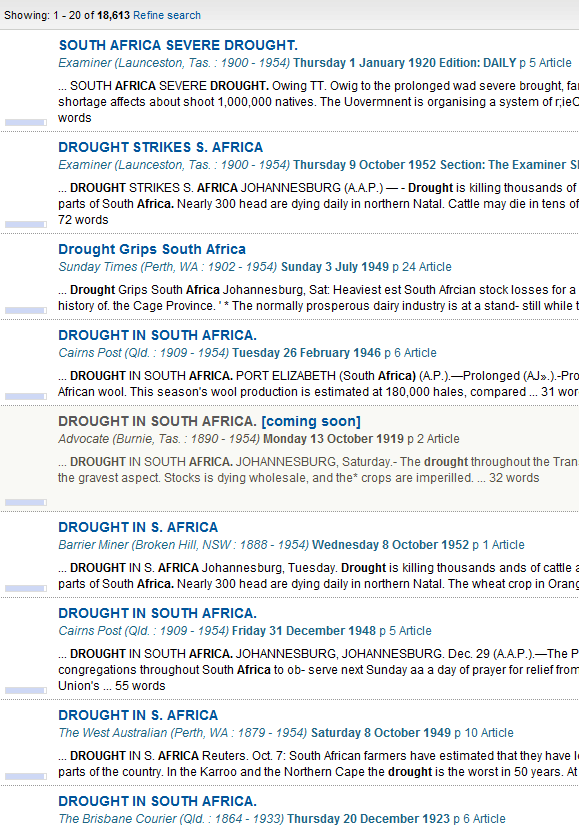The Guardian asks :
Is climate change to blame for famine in the Horn of Africa?
It’s impossible to answer with a simple yes or no – but here’s a summary of what we think we know so farThe current drought conditions have been caused by successive seasons with very low rainfall. Over the past year, the eastern Horn of Africa has experienced two consecutive failed rainy seasons. According to surveys of local communities, this is part of a long-term shift. Borana communities in Ethiopia report that whereas droughts were recorded every six to eight years in the past, they now occur every one to two years.
Only 18,000 newspaper articles about drought in Africa.



Definitely a great site that one.
When Juliar Gillard’s government wakes up to what you are using it for, they will close it down for sure.
“droughts were recorded every 6-8 years?”
“History has preserved the record of one horrible visitation by which Egypt was afflicted-the year 1199 (596 of the Flight), during May, June, and July, the waters of the river became green and fetid, and full of worms, and the rains had failed in Abyssinia, and the greater part of the lands remained parched up beneath the sun. In this state of things,” says Abd-el-Latif, who witnessed what he describes, ” the year 597 approached like a monster that threatened to destroy all the resources of life and every means of subsistence. There was no longer any hope of an additional rise in the water…”
~10 Aug 1859
http://trove.nla.gov.au/ndp/del/article/13028991/1489738?searchTerm=abyssinia drought#pstart1489738
“Famine.
Khartoum, Sat: Government is organising relief as drought in Eastern Sudan threatens thousands of nomad tribesmen with famine. Rains have failed for the second consecutive year and tribesmen’s animals are dying by hundreds.”
~17 April 1949
http://trove.nla.gov.au/ndp/del/article/59506784?
Sliding toward global cooling one would expect theses types of periods of diminished precipitation in normally “Arid” regions. With an average yearly rainfall between Las Vegas and Phoenix of 6.7 inches i would consider the region a desert. To me desert represents perpetual drought, but then I lived most of my life in a desert.
There is no global cooling near. The sun supposed to be having some downtime, but that’s not going to prevent Global Warming in the long term.
Why can’t people accept that things are heating up?
Here is Bill Maher taking skeptics to task:
http://www.youtube.com/watch?v=0OwFSLm4pII&feature=related
Why can’t people accept that things are heating up?
Not since 2001.
http://www.woodfortrees.org/plot/rss/from:2001/to:2011/plot/rss/from:2001/to:2011/trend
By the way, Brian, I suggest if you want to get upto speed on the climate debate, you don’t rely on a left wing political satirist.
You could do worse than seeing what the 1000+ scientists who disagree with the “consensus” have to say.
http://wattsupwiththat.com/2010/12/08/shredding-the-climate-consensus-myth-more-than-1000-international-scientists-dissent-over-man-made-global-warming-claims-challenge-un-ipcc-gore/
Dr Maher! How refreshing. What did Bozo the Clown have to add?
Brian and his beer reviewed science!
The 1969-73 drought.
A drought that began in 1969 continued as dry weather brought disaster to the Sahel and swept eastward through the Horn of Africa. By 1973 the attendant famine had threatened the lives of hundreds of thousands of Ethiopian nomads, who had to leave their home grounds and struggle into Somalia, Djibouti, Kenya, and Sudan, seeking relief from starvation. By the end of 1973, famine had claimed the lives of about 300,000 peasants of Tigray and Welo, and thousands more had sought relief in Ethiopian towns and villages.
http://www.photius.com/countries/ethiopia/society/ethiopia_society_refugees_drought_a~170.html
The 1984-85 and 1987-90 famines.
Famine also contributed to Ethiopia’s refugee crises. The 1984-85 famine resulted in the death or displacement of hundreds of thousands of people within Ethiopia and forced about 100,000 into Somalia, 10,000 into Djibouti, and more than 300,000 into Sudan.
In 1987 another drought threatened 5 million people in Eritrea and Tigray.
International relief agencies considered the 1990 famine more critical because of the scarcity of rain since 1987.
From the climate data summary produced by the UN.
The strong inter?annual and inter?decadal variability in Ethipoia’s rainfall makes it difficult to detect long?term trends. There is not a statistically significant trend in observed mean rainfall in any season in Ethiopia between 1960 and 2006. Decreases in JAS rainfall observed in the 1980s have shown recovery in the 1990s and 2000s.
http://www.adaptationlearning.net/climate-data/ethiopia-country-level-climate-data-summary
It is a desert region and extra rain fall is the exception to the natural state of the climate.
Bruce:
You can Cherry pick all you want but the globe has been cooling for 5 to 8 thousand years with short periods of warming mixed in. We have recently experienced one of those short periods of warming in the overall downward trend.
You mistakenly discuss weather and call it climate which is the study of long term weather patterns. The key word being “Long”. Climate does not drive weather because weather defines climate.
That was to BRIAN! I got my “B”s mixed up!
I thought it was 1998 Paul…. Some people claim 1998… Some claim 2001 and even some claim 2003. Is it that the climate scientist don’t have their story right or is it the naysayers?
Paul…. Those are not NASA climate scientist.